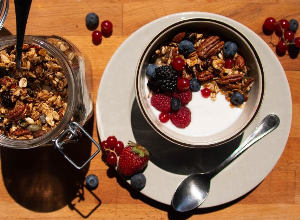Is sugar dangerous for our health?
Published 3 Feb 2023 • By Candice Salomé
Sugar, like salt, is a nutrient that our body cannot do without in order for it to function properly.
It can be found everywhere, even where we least expect it. Soft drinks, chocolate bars and other sweets contain sugar, of course, but it is also added to many other foods such as ready meals and preserves.
Numerous studies have shown that, in addition to diabetes and obesity, excess of sugar can cause many other diseases and has a negative impact on our health.
So really what is sugar and where can it be found? What is the real impact of sugar on our health? How can you reduce your sugar intake?
We explain it all in our article!

In the UK, sugar consumption in 2020 per capita reached 24.1 kilos. Current average intakes of free sugars are approximately twice the 5% recommendation.
What is sugar?
Sugar is a carbohydrate, a natural ingredient that can be found in fruit and vegetables.
It is an energy fuel that helps our cells to function properly, particularly those of the muscles, brain, heart and red blood cells.
Its aim is therefore to provide energy to our body, as well as to increase the insulin level. Insulin is a hormone naturally produced by the pancreas. It allows sugar (glucose) to enter the cells.
There is a difference between fast and slow sugars. They are distinguished by the speed at which glucose (sugar) is absorbed by the body.
There are different types of fast sugars, depending on their original source (not-exhaustive list):
- Fructose: it is the sugar from honey and fruit. It is therefore a natural product, rich in fibres, minerals and vitamins that are good for your health. However, it should not be consumed in excess, especially in case of diabetes.
- Sucrose: mainly derived from plants such as sugar cane or sugar beet. It is the table sugar.
- Dextrose: it is the sugar extracted from corn.
- Maltose: this sugar is extracted from the starch in maize or barley.
- Glucose syrup: it is a liquid sugar obtained from starch and mainly used by manufacturers.
- Lactose and galactose: these are sugars naturally contained in milk and dairy products.
Slow sugars are made up of larger, more complex molecules. They do not taste sweet. They are mainly found in the form of starch and fibres in foods such as pasta, bread, cereals (rice, wheat, corn, quinoa, etc.), potatoes and legumes (lentils, chickpeas, beans, etc.).
How does our body react when we consume sugar?
Glucose is one of the body's main fuels and is essential for maintaining good health. However, if consumed in excess, a chemical reaction produced by the body, called glycation, binds sugars to proteins. This reaction, also known as the "Maillard reaction", produces glycated proteins. It is a natural phenomenon that occurs in living organisms, particularly during the process of ageing, and in foods when they are cooked at high temperatures. Once this reaction has occurred, it is irreversible. Thus, these glycated proteins are quite harmful, because they can neither be destroyed nor evacuated by the body.
Even though glucose is essential for our metabolism, if there is an excess of it in the bloodstream, it can cause damage. This is what happens in diabetes, for example. This is why our body has set up a system to regulate glucose: the insulin production.
Glucagon, on the other hand, is a hormone that raises the blood sugar level. Like insulin, glucagon is produced in the pancreas. In a healthy person, the pancreas releases glucagon to prevent blood sugar levels from falling too low.
When fast sugar is taken in, the blood sugar level rises quickly and then falls again. Scientists tend to represent this phenomenon as an inverted V, the height of which corresponds to intensity and the width to longevity. This is called the glycaemic index (GI).
The higher the glycaemic index of a food, the more our body's glucose regulation system will be called upon. Our body will then set up a mechanism to reduce the amount of sugar to between 0.7 and 1.1 grams/litre of blood, which is the normal level for the human body. The pancreas will then go into action to secrete insulin in greater or lesser quantities depending on the needs.
In addition, after ingesting a sweet food, which causes a peak of glucose in the blood, a so-called reactive hypoglycaemia can occur. It is a sudden rise in blood sugar levels, followed by an equally rapid fall, sometimes below the normal level. This triggers the production of hunger hormones and the body thinks it needs to be fed: it's the hunger pangs! This is why it is recommended to eat breakfasts or snacks rich in fibre (slow sugars) and protein. This avoids the "rollercoaster" of blood sugar levels and prolongs the feeling of satiety.
In contrast, slow sugars are absorbed more slowly by the body and release glucose into the bloodstream more gradually. As a result, the glucose regulation system is less stressed.
Adequate nutrition therefore depends largely on the way in which carbohydrates are delivered to our body.
What are the health risks linked to consuming sugar?
Lipids (fats) have long been held responsible for the global obesity pandemic and still have a very bad reputation.
Nevertheless, numerous studies have suggested a causal relationship between excessive carbohydrate consumption and various metabolic diseases such as cardiovascular disease, obesity, type 2 diabetes, non-alcoholic fatty liver disease, gout disease and certain cancers.
Sugar and obesity
According to numerous studies, sugar has a role to play in weight gain. Indeed, the rapid rise in insulin levels increases the feeling of hunger outside mealtimes, which leads to eating more than is reasonable. However, sugar is not the only factor responsible for weight gain (sedentary lifestyle, certain medicines, genetic, endocrine and metabolic factors, etc.).
Sugar and type 2 diabetes
Type 2 diabetes is a metabolic disease characterised by an impaired insulin response.
Excessive consumption of carbohydrates (particularly fast sugars) increases the risk of weight gain and obesity. Weight gain is a recognised risk factor for the development of type 2 diabetes. About 85% of people with diabetes mellitus are overweight or obese.
In contrast, weight loss can, for some patients, lead to better control of blood glucose levels and even to remission.
Sugar and cardiovascular diseases
Sugar, when consumed in excess, irritates the arterial vessels. The inner wall of these vessels become more porous. Cholesterol tends to enter the arteries more easily and forms atheromatous plaques (fatty deposits on the inner surface of the artery wall). This can cause the arterial vessels to become blocked. If the arteries of the heart are affected, it is a myocardial infarction. If the arteries of the brain are affected, it is a stroke.
In addition, the degradation of the vascular walls causes the increase in blood pressure. This in turn degrades these walls: a vicious circle sets in.
Sugar and non-alcoholic steatohepatitis (NASH)
Non-alcoholic steatohepatitis (NASH) is the accumulation of fat in the liver cells. Fat in the liver usually develops when a person consumes more fats and sugars than their body can handle. The disease tends to develop more easily in people who are overweight or obese. Non-alcoholic fatty liver disease (NAFLD) can also develop in a person who has a healthy body weight, but usually eats a lot of sugary and fatty foods and has extra fat around the waist.
How can we reduce the amount of sugar consumed?
In view of the deleterious effects of excess sugar on our health, public health authorities recommend limiting the intake of simple sugars.
In the UK, the recommended maximum amount of free sugars (added to food and drinks, not the ones naturally found in food) to be consumed daily by an adult is 30 grams.
Carenity gives you some advice on how to limit your sugar intake:
- Avoid liquid calories: sugary drinks such as sodas, fruit juices (as sweet as sodas, prefer whole fruit), sweetened hot drinks. They contain a lot of sugar and have no nutritional value.
- Choose whole foods. These are foods that are as close to their natural state as possible and have not been processed much.
- Choose your snacks wisely: nuts, plain yoghurt or fresh fruit, for example.
- Use low-sugar cereals.
- Cook at home more often and choose low-sugar recipes. In your favourite recipes, feel free to reduce the amount of sugar by a quarter or a third.
Check the nutrition labels and the list of ingredients on packaged foods. The nutrition labels contain the information about the total amount of sugar (natural or added) in the product, and the ingredient list tells you where the sugar comes from.
>> Read our article: “How to spot hidden sugars in food?” <<
Share your thoughts and questions with the community in the comments below!
Take care!
Sources :
Les méfaits du sucre dans l’alimentation, Revue Médicale Suisse
Sucres dans l’alimentation, Anses
Le sucre, un facteur de risque de cancer ?, Inrae
Comment le sucre en excès abîme le cœur, Le Figaro Santé
Pourquoi manger moins de sucre permet de vivre plus longtemps en meilleure santé, Le Figaro Santé
1 comment
You will also like

The Hypotoxic (Seignalet) diet: Is it effective for certain chronic illnesses?
23 Jul 2021 • 6 comments

 Facebook
Facebook Twitter
Twitter


